Bedienungsanleitung Nomad Masai 2 TC Zelt
Benötigen Sie ein Bedienungsanleitung für Ihren Nomad Masai 2 TC Zelt? Unten können Sie das PDF-Bedienungsanleitung kostenlos auf Deutsch ansehen und herunterladen. Für dieses Produkt gibt es derzeit 7 häufig gestellte Fragen, 0 Kommentare und 1 Stimme mit einer durchschnittlichen Produktbewertung von 100/100. Wenn dies nicht das von Ihnen gewünschte Bedienungsanleitung ist, kontaktieren Sie uns bitte.
Ist Ihr Produkt defekt und bietet die Bedienungsanleitung keine Lösung? Gehen Sie zu einem Repair Café, wo es gratis repariert wird.
Bedienungsanleitung
Loading…


Loading…
Bewertung
Teilen Sie uns mit, was Sie über die Nomad Masai 2 TC Zelt denken, indem Sie eine Produktbewertung verfassen. Möchten Sie Ihre Erfahrungen mit diesem Produkt teilen oder eine Frage stellen? Hinterlassen Sie einen Kommentar am Ende dieser Seite!Mehr zu diesem Bedienungsanleitung
Wir verstehen, dass es schön ist, ein gedrucktes Bedienungsanleitung für Ihr Nomad Masai 2 TC Zelt zu haben. Sie können das Bedienungsanleitung jederzeit von unserer Website herunterladen und selbst ausdrucken. Wenn Sie ein Originalhandbuch wünschen, empfehlen wir Ihnen, Nomad zu kontaktieren. Möglicherweise können sie ein Originalhandbuch bereitstellen. Suchen Sie das Bedienungsanleitung Ihres Nomad Masai 2 TC Zelt in einer anderen Sprache? Wählen Sie auf unserer Homepage Ihre bevorzugte Sprache und suchen Sie nach der Modellnummer, um zu sehen, ob wir sie verfügbar haben.
Spezifikationen
| Marke | Nomad |
| Modell | Masai 2 TC |
| Kategorie | Zelte |
| Dateityp | |
| Dateigröße | 0.31 MB |
Alle Anleitungen für Nomad Zelte
Weitere Anleitungen von Zelte
Häufig gestellte Fragen zu Nomad Masai 2 TC Zelt
Unser Support-Team sucht nach nützlichen Produktinformationen und beantwortet Ihre häufig gestellten Fragen. Sollte Ihnen ein Fehler bei den häufig gestellten Fragen auffallen, teilen Sie uns dies bitte anhand unseres Kontaktformulars mit.
Kann ich mein Zelt einlagern, wenn es noch nass ist? Verifiziert
Nur für einen kurzen Zeitraum. Wenn Sie ein nasses Zelt eine Woche oder länger einlagern, kann sich Schimmel bilden. Das ist sowohl für das Zelt als auch Ihre Gesundheit schädlich.
Das war hilfreich (384) Mehr lesenWie imprägniere ich ein Zelt? Verifiziert
Schlagen Sie das Zelt auf, reinigen Sie das Tuch und lassen Sie es trocknen. Sprühen Sie das Imprägnierungsmittel mit einem Pflanzenspray oder einem anderen Spray auf das Tuch. Sie können auch eine Farbwalze oder eine Bürste verwenden. Das Tuch muss vollständig mit dem Imprägnierungsmittel besprüht werden. Behandeln Sie auch das Innere des Zelts. Reinigen Sie alle Fenster gründlich mit einem feuchten Lappen. Das Imprägnierungsmittel darf nicht darauf trocknen. Lassen Sie das Zelttuch vollständig trocknen. Wiederholen Sie gegebenenfalls die Behandlung.
Das war hilfreich (285) Mehr lesenKann ich einen Riss oder ein Loch im Tuch meines Zelts selbst reparieren? Verifiziert
Es gibt spezielle selbstklebende Stoffflicken für synthetische Zelttücher. Befestigen Sie einen dieser Flicken auf beiden Seiten des Lochs oder Risses. Bei Zelttüchern aus Baumwolle oder verschiedenen Materialien sollten Sie am besten Flicken verwenden, die aufgebügelt werden können. Dazu benötigen Sie ein Bügeleisen.
Das war hilfreich (218) Mehr lesenDer Reißverschluss meines Zelts geht nicht reibungslos auf und zu. Was kann ich tun? Verifiziert
Wenn ein Reißverschluss nicht reibungslos auf und zu geht, verwenden Sie einen PTFE- oder Silikon-Spray. Sprühen Sie den Inhalt der Flasche nicht auf das Tuch und verwenden Sie den Spray auch nicht präventiv zur Vermeidung möglicher zukünftiger Probleme.
Das war hilfreich (156) Mehr lesenEs sind Wassertropfen an der Innenwand des Zelts. Bedeutet das, dass es undicht ist? Verifiziert
Nein, es handelt sich dabei wahrscheinlich um Kondensation. Achten Sie auf eine ordnungsgemäße Belüftung, um Kondensation zu minimieren.
Das war hilfreich (129) Mehr lesenWelche Zeltheringe eignen sich am besten für welchen Untergrund? Verifiziert
Auf Wiesen oder Waldböden können Sie halbrunde Heringe oder Heringe aus Plastik verwenden. Auf steinigem Untergrund benötigen Sie Felsbodenheringe. Auf Lehmböden können Sie halbrunde oder universelle Heringe oder Heringe aus Plastik verwenden. Auf Kies benötigen Sie halbrunde oder universelle Heringe und auf Sand Heringe aus Holz.
Das war hilfreich (105) Mehr lesenDas Imprägnierungsmittel hinterlässt weiße Flecken oder eine weiße Trübung auf dem Zelttuch. Was kann ich dagegen tun? Verifiziert
Wenn das Mittel weiße Flecken oder eine weiße Trübung auf dem Zelttuch hinterlässt, bedeutet das, dass Sie auf den jeweiligen Stellen mehr Imprägnierungsmittel verwendet haben. Dies schädigt das Tuch nicht und häufig verschwinden die Flecken mit der Zeit wieder. Es wird davon abgeraten, weniger Imprägnierungsmittel zur Vermeidung von Flecken zu verwenden. Das Tuch muss vollständig mit dem Imprägnierungsmittel besprüht werden, um ein zufriedenstellendes Ergebnis zu erzielen.
Das war hilfreich (97) Mehr lesen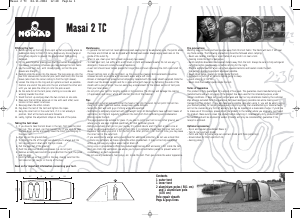


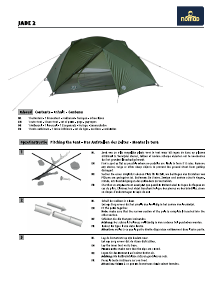
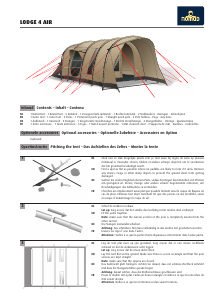
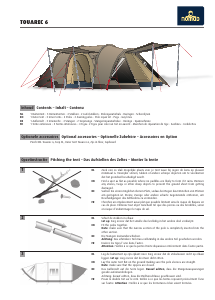


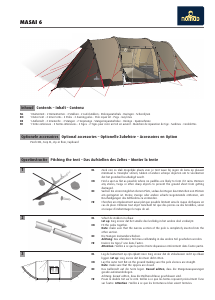
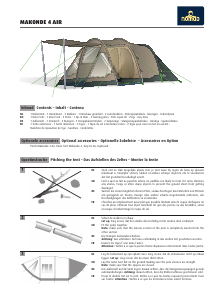
Diskutieren Sie über dieses Produkt mit
Hier können Sie uns Ihre Meinung zu Nomad Masai 2 TC Zelt mitteilen. Wenn Sie eine Frage haben, lesen Sie zunächst das Bedienungsanleitung sorgfältig durch. Die Anforderung eines Bedienungsanleitung kann über unser Kontaktformular erfolgen.